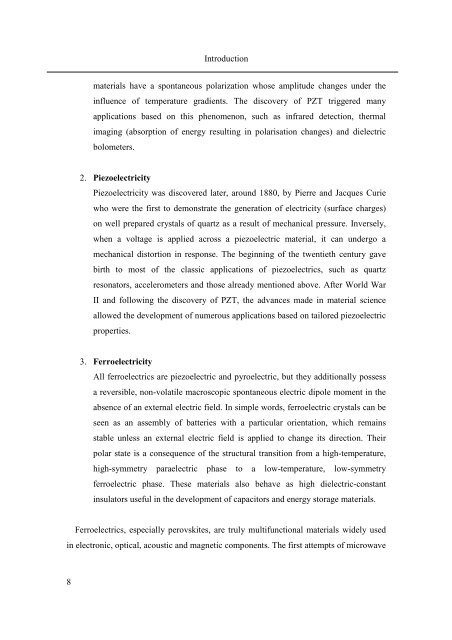PhD Thesis Arne Lüker final version V4 - Cranfield University
PhD Thesis Arne Lüker final version V4 - Cranfield University
PhD Thesis Arne Lüker final version V4 - Cranfield University
You also want an ePaper? Increase the reach of your titles
YUMPU automatically turns print PDFs into web optimized ePapers that Google loves.
8<br />
Introduction<br />
materials have a spontaneous polarization whose amplitude changes under the<br />
influence of temperature gradients. The discovery of PZT triggered many<br />
applications based on this phenomenon, such as infrared detection, thermal<br />
imaging (absorption of energy resulting in polarisation changes) and dielectric<br />
bolometers.<br />
2. Piezoelectricity<br />
Piezoelectricity was discovered later, around 1880, by Pierre and Jacques Curie<br />
who were the first to demonstrate the generation of electricity (surface charges)<br />
on well prepared crystals of quartz as a result of mechanical pressure. Inversely,<br />
when a voltage is applied across a piezoelectric material, it can undergo a<br />
mechanical distortion in response. The beginning of the twentieth century gave<br />
birth to most of the classic applications of piezoelectrics, such as quartz<br />
resonators, accelerometers and those already mentioned above. After World War<br />
II and following the discovery of PZT, the advances made in material science<br />
allowed the development of numerous applications based on tailored piezoelectric<br />
properties.<br />
3. Ferroelectricity<br />
All ferroelectrics are piezoelectric and pyroelectric, but they additionally possess<br />
a reversible, non-volatile macroscopic spontaneous electric dipole moment in the<br />
absence of an external electric field. In simple words, ferroelectric crystals can be<br />
seen as an assembly of batteries with a particular orientation, which remains<br />
stable unless an external electric field is applied to change its direction. Their<br />
polar state is a consequence of the structural transition from a high-temperature,<br />
high-symmetry paraelectric phase to a low-temperature, low-symmetry<br />
ferroelectric phase. These materials also behave as high dielectric-constant<br />
insulators useful in the development of capacitors and energy storage materials.<br />
Ferroelectrics, especially perovskites, are truly multifunctional materials widely used<br />
in electronic, optical, acoustic and magnetic components. The first attempts of microwave

















